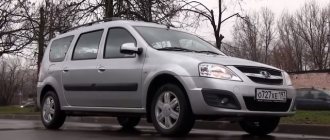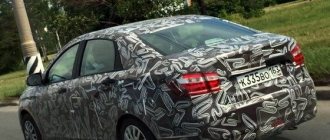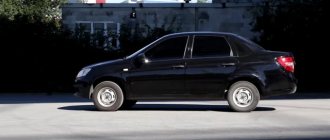Every driver hopes to avoid accidents on the road. But to choose the right tactics on the road, you need to know what the car is capable of and what its internal reserves are. To do this, it is better to have an idea of how cars are tested for strength, how to protect the car, and familiarize yourself with the results shown by the crash test of the VAZ 2114.
Crash test vaz 2114
Car testing
World standards for vehicle inspection are approved by the international organization EuroNCAP. It also checks most new machine models before putting them on production line and issues safety certificates. The test is carried out using a special technique, including testing the machine for strength while simultaneously recording a video report and taking readings from sensors that transmit data on overloads to the computer.
As a result of the test, the car is awarded points, which are an indicator of its active and passive safety. Despite the lack of data on official EuroNCAP tests for the VAZ 2114, there are independent laboratories in Russia that conduct similar tests using the EuroNCAP method.
Head-on collision
The test consists of three stages:
- Head-on collision at 64 km/h with a stationary obstacle.
- Side collision.
- Collision with a pole.
Head-on collision effect
Safety assessments are carried out for:
- driver and front passenger safety;
- child safety;
- pedestrian safety.
The assessment includes the level of vehicle damage and the condition of electronic safety features after collisions.
Result of a head-on collision
In 2004, Autoreview magazine conducted a partial crash test using the EuroNCAP method. Only frontal collision risks were assessed.
Lada 2115 2004, engine Gasoline 1.5 liter., 77 hp, Front drive, Manual - DIY
Comments 16
Damn, it will squeak like that when the dimensions are burnt out, or there is not enough antifreeze... this is an extremely unpleasant melody :-)
That's right, safety comes first. By the way, many people don’t know, but the first Samaras with a high panel also have a seat belt indicator. However, I'm not sure that presence and belt sensors were ever installed in them.
yes, safety comes first!) and it wouldn’t hurt the plant to connect all this right away at the plant.
At the factory, such sensors were installed only on export vehicles
That's right, safety comes first. By the way, many people don’t know, but the first Samaras with a high panel also have a seat belt indicator. However, I'm not sure that presence and belt sensors were ever installed in them.
I have an export one. There's nothing there. I don’t think anyone would bother removing the sensor from the seat and replacing the belt buckles with regular ones.
Damn, why do you need this, it’s on my father’s Toyota, I don’t know how it got up already
I don’t know, but for some reason I want to connect)
I understand, I understand, sometimes you want to add something like that, well, it’s up to you, maybe you’ll like it) it just bothers me because I don’t forget to buckle up, but sometimes on a bad road it’s more convenient without a belt, but she screams like a bitch until you buckle up)
Thanks Dima!) Now it’s clear)
From the lock sensor, through the central part of the beard, you lead one wire (black and white) to the BSK of the dashboard. In the BSK connector (plug) in the free socket under No. 4, insert the “mother” terminal with the crimped (black and white) wire. The principle of operation is as follows: when the seat belt is not fastened, the sensor located on the lock is closed to the vehicle ground, which in turn is perceived by the BSK as an unfastened belt, which they signal. When the seat belt is fastened in the lock, the mass disappears, the BSK is silent.
Damage to the driver and passenger
During the collision, the dummy hit its head first on the rim and then on the steering wheel hub. At the same time, the sensors showed that no serious injuries to the head, neck and chest were recorded due to the deceleration of the car.
Driver injuries
The mannequin's shins were injured when they were caught between the raised floor and a knocked-out panel. The shin injury criterion (Tibia Index) exceeded the dangerous level for both legs. The kneecaps collapsed due to the pressure of the metal parts of the engine shield. The readings from the “femoral” sensors turned out to be lower. Child and rear passenger dummies were not used during the test.
Vehicle damage
The front end was crumpled all the way to the driver's door. The driver's door itself, having broken, despite the presence of a safety bar, failed and became jammed. The door opening was reduced by 110 mm. The glass frame turned outward and the glass was broken. The rest of the doors opened without effort.
The steering wheel has moved 230-110-100 mm back and up and to the right. The front panel was torn away from the body, the engine shield ended up in the cabin, having shifted by 500 mm. The floor flattened and curved upward. The clutch and brake pedals moved back 300 mm.
The seat “slide” could not withstand the impact and slid forward during the collision along with the “driver” dummy. The crash test showed the condition and quality of the welds and connections of the power elements of the body.
Vehicle damage
Lada 2115 2004, engine Gasoline 1.5 liter., 77 hp, Front drive, Manual - DIY
Comments 16
Damn, it will squeak like that when the dimensions are burnt out, or there is not enough antifreeze... this is an extremely unpleasant melody :-)
That's right, safety comes first. By the way, many people don’t know, but the first Samaras with a high panel also have a seat belt indicator. However, I'm not sure that presence and belt sensors were ever installed in them.
yes, safety comes first!) and it wouldn’t hurt the plant to connect all this right away at the plant.
At the factory, such sensors were installed only on export vehicles
That's right, safety comes first. By the way, many people don’t know, but the first Samaras with a high panel also have a seat belt indicator. However, I'm not sure that presence and belt sensors were ever installed in them.
I have an export one. There's nothing there. I don’t think anyone would bother removing the sensor from the seat and replacing the belt buckles with regular ones.
Damn, why do you need this, it’s on my father’s Toyota, I don’t know how it got up already
I don’t know, but for some reason I want to connect)
I understand, I understand, sometimes you want to add something like that, well, it’s up to you, maybe you’ll like it) it just bothers me because I don’t forget to buckle up, but sometimes on a bad road it’s more convenient without a belt, but she screams like a bitch until you buckle up)
Thanks Dima!) Now it’s clear)
From the lock sensor, through the central part of the beard, you lead one wire (black and white) to the BSK of the dashboard. In the BSK connector (plug) in the free socket under No. 4, insert the “mother” terminal with the crimped (black and white) wire. The principle of operation is as follows: when the seat belt is not fastened, the sensor located on the lock is closed to the vehicle ground, which in turn is perceived by the BSK as an unfastened belt, which they signal. When the seat belt is fastened in the lock, the mass disappears, the BSK is silent.
Test results
The car scored 3.2 points out of 16 possible. The test results were lower than those of the VAZ 2109, which scored 3.7 points out of 16. Only the indicators of the condition of the chest and cervical vertebrae of the dummy “driver” were better than those of the “nine”, which received less damage due to the injury-proof panel and steering wheel .
Conclusions of the magazine's experts: the main problem of the VAZ 2114 is the strength of the body and the lack of passive safety elements. The best result of the VAZ 2109 is due to the presence of a powerful aluminum beam in the bumper. In a frontal impact, the beam takes the impact and redistributes the collision energy.
Comparison of results
The absence of which passive safety elements led to the penalization (downgrade of the rating) of the VAZ 2114:
- Front seat belt pretensioners.
- Driver airbags.
- Front seat belt force limiters.
- Passenger airbags.
- Side airbags.
- "Curtain" security.
- Driver knee airbags.
Special alarm for unfastened seat belts
A signal that goes off when seat belts are not fastened is one of the most interesting options that cars are equipped with. The whole paradox is that if such a signal is installed on a car, then often you want to turn it off or remove it, and in the case when it is not there, then there is a desire to install it. Currently, according to the law, fines for not wearing a seat belt have increased significantly, and this is the reason why many owners of domestic cars want to install such an option on their car.
For the VAZ 2110 car model, a similar option may be provided by the manufacturer, but for some reason, it is often not installed in the car design itself, even on the assembly line. Sometimes you may notice that the On-Board Control System has indicators and special connectors for this option, but there are no special built-in sensors in the buckles provided for seat belts.
Basic principles and rules of operation of the installed seat belt signal
In the event that the seat belt is not fastened, a contact is made to ground on the vehicle. When a seat belt is fastened, as a result of a rupture of the mass, the contacts are disconnected, as a result of which the characteristic signal disappears.
The presence in the circuit of a passenger presence sensor, installed specifically so that the seat belt warning light does not go off when the passenger is not in the front seat, and there is no certain weight on the passenger seat, then there is a break in the circuit so that the signal does not go off, in such a option.
When a passenger sits down in the front seat, as a result of the pressure created, the sensor contacts close and a signal is triggered. Once the seat belt buckle is closed, the contacts are disconnected and the signal disappears.
The principle of operation of a chain made by yourself is no different from the principle of operation of a chain made at a factory. In the case when there is only one unbelted driver in the car, then only the driver’s seat belt locking controller is activated, and if there is also a passenger in the car, then their seats are also monitored.
The only difference will be in the signaling itself. In non-Russian cars the sound of the signal will be constant and often increasing, while in domestic cars the sound signal lasts only three times, immediately after the car engine starts running. After this, the signal disappears and only the indicator on the panel lights up, indicating that the seat belt is not fastened.
How to properly modify the seat belt buckle of a domestic car
The main reason why it is necessary to modify the lock is that it is necessary to make sure that the lock has the ability to determine the modes - fastened, not fastened. And this can only happen if the vehicle mass is closed and opened.
First, you need to dismantle the seat belt buckles using a 17mm wrench, without the need to perform any manipulations with the seats. The next step is to disassemble the lock using a screwdriver and knife. When disassembling the lock, you need to carefully separate the lock along the seam into two halves and remove it from the locking mechanism.
In the case where the lock is made in a solid body, you just need to pull it down.
You need to stock up on thin wire and small self-tapping screws.
A self-tapping screw is attached to the end of the wire, and then everything must be placed inside the spring.
When there is constant movement of the spring in the lock itself (compression and release), the wiring inserted into the lock is subjected to mechanical stress (moving and biting), which leads to its break. In this case, the mechanism will last no more than a week at best.
This design ensures that there is no movement of the wire, and the operation is carried out only due to the spring contact.
In the role of the necessary contact, you can use a spring, which is used in the design of a conventional ballpoint pen. Such a spring has a number of necessary advantages, due to its curved shape, which provides the spring with movement in the opposite direction.
In the case of an ordinary piece of wiring, sooner or later it will begin to bend, which means loss of contact.
The spring from the ballpoint pen must be unbent and then connected to the signal wire. This circuit element must be connected to the moving part of the lock in such a way that no electrical contact occurs.
As a result, the resulting connection looks like two parallel contacts isolated from each other.
It is necessary to select a certain position for the contact created using a piece of wiring, so that in the position when the lock is open, the contact rod should not touch the lock, and when the lock is closed, it should touch.
Now you can move on to the stage of assembling the lock into its plastic case, having previously provided an additional hole for the wire.
This method can be called more practical, since problems and shortcomings do not appear as a result of operation.
It all starts again with disassembling the seat belt buckle. The next step is to remove the white part - it houses the spring mechanism.
Then, you should take a regular disposable lighter and remove the valve from it. By pressing firmly on the thin tube, we remove the insides.
You need to insert a thin tube taken from the lighter into the spring, but first you need to adjust it to the size of the spring.
A piece of copper wire should be placed on the existing plastic part located in the seat belt latch. For copper wire, a certain rule should be taken into account - it should be no thicker than one millimeter and not have varnish insulation.











